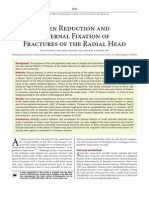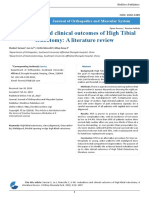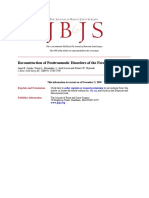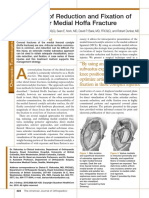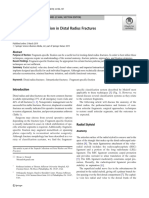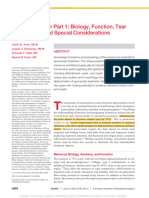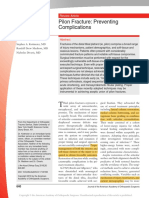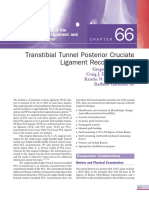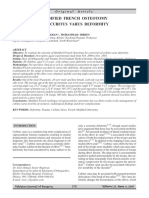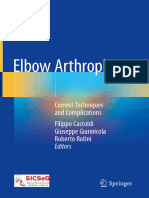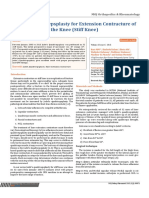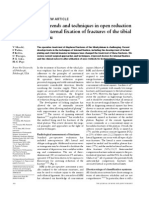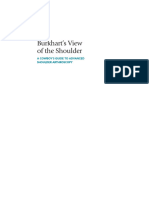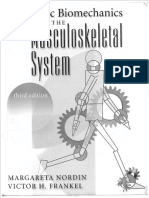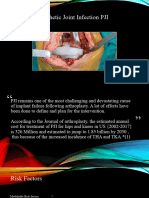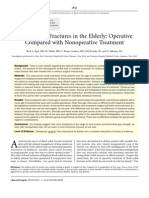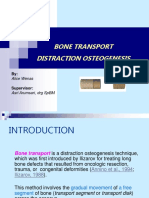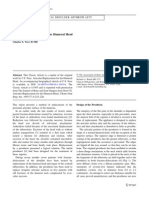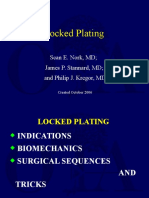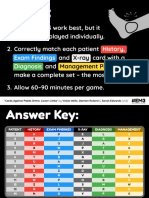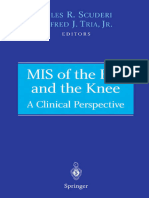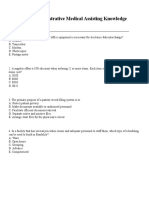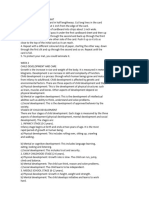Malunions of The Distal Radius
Malunions of The Distal Radius
Uploaded by
Sivaprasath JaganathanCopyright:
Available Formats
Malunions of The Distal Radius
Malunions of The Distal Radius
Uploaded by
Sivaprasath JaganathanOriginal Description:
Original Title
Copyright
Available Formats
Share this document
Did you find this document useful?
Is this content inappropriate?
Copyright:
Available Formats
Malunions of The Distal Radius
Malunions of The Distal Radius
Uploaded by
Sivaprasath JaganathanCopyright:
Available Formats
12
Malunions of the Distal Radius
Sameer J. Lodha, MD
Robert W. Wysocki, MD
Mark S. Cohen, MD
Fractures of the distal radius are common injuries, comprising
approximately 8% to 17% of fractures seen in the emergency
department.13 These injuries largely occur in 2 distinct populations: a smaller subset composed of high-energy fractures,
which are often seen in young adults, and a larger group of
low-energy fragility fractures, which are more frequently
noted in older adults. The overall incidence of the injury is
expected to increase over the next 20 years, paralleling the
aging of the US population as a whole.46,7
Treatment paradigms for distal radius fractures have
evolved significantly as the biomechanics of the wrist have
been elucidated. Although initial descriptions classified distal
radius fractures as a largely homogenous group of injuries that
healed well with minimal treatment, it is now recognized that
these injuries display significant variation in fracture pattern
and stability, with certain fracture deformities leading to poor
prognosis if left uncorrected.4,8 Considerable effort has been
expended in investigating and determining appropriate treatments for different fracture types, taking into account patientspecific factors including functional demands and overall
health. In spite of significant advances in developing treatment
strategies, complication rates from improper or failed treatment regimens remain high, ranging from 23% to 31%.9,10
Malunion is the most common complication following
distal radius fractures. This occurs in approximately 23%
of nonsurgically treated injuries and approximately 11% of
operatively treated fractures.2,11,12 Malunions may be extraarticular (involving the metaphyseal region) or intra-articular
(manifesting with residual joint incongruity) and can present
along a spectrum of severity, ranging from asymptomatic radiographic abnormalities to disabling deformities associated
with significant pain and functional impairment. The incidence of clinically apparent malunions will likely increase in
the future, reflecting both the overall increase in distal radius
fractures and the increased functional demands of a longerliving adult population.1315
Historically, treatment for clinically significant malunion
has been operative, consisting primarily of corrective osteotomies with adjunct bone grafting and fixation. Recent research
to define optimal treatment protocols for malunions has
American Society for Surgery of the Hand
HSUV_Chapter-12.indd 125
focused on: (1) determining the appropriate indications for
intervention; (2) developing appropriate surgical techniques
incorporating new insights into the biomechanics of wrist
function; and (3) developing new technologies to improve
the accuracy and efficacy of operative intervention. In this
chapter we will attempt to provide a summary of the current
literature regarding distal radius malunions while detailing
some of the work that has gone into addressing the questions
listed above.
Anatomy
The normal functional anatomy of the distal radius is welldescribed. The articular surface is divided by a longitudinal, sagittal ridge into 2 facets for the scaphoid and lunate
respectively. A third key articulation, the distal radioulnar
joint (DRUJ), is composed of the distal ulna and the sigmoid
notch on the ulnar surface of the distal radius. This is the
anatomic location of forearm rotation, allowing the radius
and the carpus to rotate around the ulna. Four radiographic
measures with well-established normal values are commonly
used to describe the anatomy of the distal radius and are essential for accurately evaluating malunions. The distal radius
typically demonstrates a palmar inclination of approximately
11 to 12, a radial inclination of 22 to 23, a radial length
of 11 to 12 mm, and an ulnar variance of 1 mm on a neutral
rotation posterior-anterior (PA) radiograph. Ulnar variance
differs greatly among individuals and should be evaluated by
comparison to the contralateral, uninjured extremity. The
magnitude of acceptable postinjury deviation from these normal parameters has also been established. Most authors agree
that palmar inclination between 15 dorsal to 20 volar, radial
tilt >15, radial length between 7 to 15 mm, and ulnar variance <3 mm from the contralateral side are compatible with
acceptable alignment.1,15,16
Deformity beyond the limits defined above correlates
with significant alterations in the normal biomechanics of
the wrist, with associated clinical manifestations. In the normal wrist, approximately 82% of the axial load is distributed
onto the radius with the remaining 18% borne by the distal
125
08/12/2011 19:15:35
Hand Surgery Update V
ulna through the triangular fibrocartilage complex. With
2.5-mm radial shortening, this relationship changes so that
the ulna bears 42% of the axial load. Continued shortening further increases ulnar load bearing and can result in
symptoms of ulnocarpal abutment. Radial shortening has
further deleterious effects in that it alters the congruency of
the DRUJ and increases tension on the triangular fibrocartilage complex; these changes can result in increased pain and
decreased rotation at the DRUJ, with nearly 50% loss in
pronation and approximately 30% loss in supination with
10-mm shortening.1721
Dorsal angulation has similar effects on force distribution
by shifting the locus of axial load bearing from volar-radial
to dorsal-ulnar. At 20 dorsal angulation, the load seen by
the ulna increases to 50% of the total; at 45 angulation this
increases to 67% of the total load. Dorsal angulation also
affects DRUJ mechanics by altering the congruity of this joint,
increasing the likelihood of range of motion deficits in forearm rotation and symptomatic instability. Carpal biomechanics are affected as well, with patients developing 1 of 2
patterns of instability. One subset develops dorsal radiocarpal
subluxation while maintaining midcarpal anatomy; a separate
subset tends to progress to an adaptive dorsal intercalated segment instability (DISI) deformity, with a flexion deformity
developing at the midcarpal joint in an effort to compensate.
Evidence suggests that the latter subset is more frequently
symptomatic.22 Both deformity types tend to lead to deficits
in wrist flexion and forearm supination. Dorsal angulation
malunion can also cause an unsightly deformity (Fig. 1A).
Volar angulation deformities, commonly seen as a product of
Smiths fractures, will often result in deficits in extension and
forearm rotation.2325
Figure 1: A) Clinical photograph of dorsally-angulated malunion following distal radius fracture. B) Preoperative template for
design of osteotomy. C) Template illustrating magnitude and direction of correction of the distal fragment following osteotomy.
D) Posteroanterior and E) lateral radiographs showing significant dorsal angulation, radial shortening, and DRUJ incongruity. Dorsal
translation of the carpus is also noted.
126
HSUV_Chapter-12.indd 126
American Society for Surgery of the Hand
08/12/2011 19:15:38
Malunions of the Distal Radius
Decreases in radial inclination are another common feature of extra-articular malunions that can interfere with normal wrist biomechanics. The changed position of the carpal
tunnel is hypothesized to decrease the mechanical advantage
of the finger flexors, reducing grip strength. Decreases in
radioulnar deviation are also commonly noted. Finally, decreases in radial inclination are thought to be associated with
changes in load-bearing across the wrist, with increased force
transmitted across the lunate facet of the distal radius.26
Intra-articular involvement is frequently noted in distal
radius fractures. While mild incongruence, as seen following
low-energy fractures in older patients, is often well-tolerated,
this is generally not the case in younger, more active individuals. Numerous studies have found that greater than 1 to 2 mm
of residual radiographic intra-articular stepoff after healing of
distal radius fractures is associated with radiographic radiocarpal arthritis and a poor clinical outcome, especially in young
patients.2730
American Society for Surgery of the Hand
HSUV_Chapter-12.indd 127
E
Figure 1: (Continued)
127
08/12/2011 19:15:39
Hand Surgery Update V
Evaluation
Initial evaluation of the patient with a malunion consists of
a detailed history and physical examination, with specific
emphasis placed on eliciting the common findings of a history of pain, weakness, decreased range of motion, instability,
or neurologic symptoms. The patients handedness, overall
health, functional demands, and expectations should be documented as these can strongly affect the choice of treatment.
Attempts should be made to localize any pain to a specific
anatomic locus, especially distinguishing between radiocarpal
versus ulnar-sided wrist pain.
Physical examination, with comparison to the contra
lateral uninjured side, should test grip strength, range of
motion in flexion/extension, pronation/supination, and radial/ulnar deviation, as well as stability at the DRUJ, radiocarpal, and midcarpal joints. Specific tender points should be
identified. Particular attention should be directed to the ulnar
side of the wrist, eliciting tenderness and/or signs of ulnocarpal abutment. A neurologic examination can help identify
features of complex regional pain syndrome (CRPS), carpal
tunnel syndrome, or other neurologic deficits. Information
should also be obtained regarding the initial injury, including
the mechanism and treatment. As part of this evaluation, previous radiographs, including those of the initial injury, should
be obtained and reviewed if possible.
Further radiographic evaluation will be essential. This begins with a minimum of a neutral rotation PA and lateral view
of each wrist. It is essential to image the contralateral wrist in
order to obtain a baseline for comparison. These radiographs
will allow determination of the anatomic parameters defined
earlier and quantification of the magnitude and direction of
the malunion. Additional radiographs can be very useful if
further evaluation is deemed necessary. Directing the beam
for the lateral view 20 to 25 distal to proximal will permit
visualization of the distal radius articular surface; further information regarding the articular surface can be gleaned from
oblique views, with the partially supinated oblique PA view to
evaluate the dorsal facet of the lunate fossa and the partially
pronated view to improve visualization of the radial styloid.31
In cases of significant articular surface disruption, or considerable rotational deformity, plain radiographs may not
provide sufficient information. Several studies have established that plain films consistently underestimate the magnitude of intra-articular disruption in distal radius fractures.
In these cases, computed tomography (CT) scans, with sagittal, coronal and 3-dimensional reconstructions can improve
quantification of the deformity and understanding of fracture
fragment morphology compared with plain films.12
Treatment
The goal of treatment of a distal radius malunion is to provide
a pain-free wrist that meets the functional demands of the
128
HSUV_Chapter-12.indd 128
patient. The corollary to this is that patients with significant
anatomic abnormalities, clinically or on radiographic examination, may not require intervention if they are pain-free and
able to function adequately given their current and anticipated
functional requirements. Other relative contraindications to
operative intervention include poor overall health, advanced
posttraumatic arthritis, severe osteoporosis, complex intraarticular deformity, and existing features of CRPS. In these
cases, physical therapy may help achieve soft tissue adaptation. If operative treatment is warranted, a salvage procedure
such as a partial or total wrist fusion may be preferred.
On the other hand, activity-limiting symptoms or severe
deformity with an increased risk for degenerative arthritis or
ulnocarpal abutment in a patient with expected high functional demands is an indication for operative treatment. In
these situations, the goal is to restore the normal anatomy
of the wrist, or at the very least, restore wrist anatomy to
within the acceptable parameters described earlier. In this
way near-normal biomechanics can be reestablished, thereby
reducing pain, improving function, and diminishing areas of
abnormal articular stress concentration.
Proper preoperative planning is essential in this process.
Planning begins by comparing the injured and uninjured
wrists, including templating (Fig. 1B, C). This will allow
precise quantification of the magnitude and direction of the
deformity to help define the following features of the appropriate treatment strategy: (1) the nature and direction of
the proposed osteotomy (opening vs. closing, volar vs. dorsal); (2) the need for and type of bone graft to be used; and
(3) the requirement for any additional ulnar-sided procedures.
Determination of the timing of any proposed intervention
is also an important part of the planning process. Although
some studies have determined that equivalent clinical results
are obtained from early intervention (<8 weeks) and late intervention (>40 weeks), others have shown that earlier surgery is
technically easier and reduces the overall period of disability.
However, delay may be an appropriate strategy in select cases
of significant comminution or established malunion. In the
former, delaying surgery until some measure of consolidation
has occurred may facilitate the ultimate procedure. In the latter, physical therapy in the interval prior to definitive treatment may improve mobility and soft tissue balance.3234
Dorsally angulated malunions (Fig. 1D, E) are typically
treated with a dorsal opening wedge osteotomy. The advantage of the opening wedge osteotomy over the closing wedge
variant is that it effectively lengthens the radius, thereby ameliorating any radial shortening deformity. A closing wedge
osteotomy, on the other hand, will likely accentuate axial
shortening. By creating a free distal fragment, opening wedge
osteotomies also permit multiplanar deformity correction, restoring more normal radial and volar inclination in the distal
radius. There are 2 salient disadvantages associated with the
opening wedge technique. First, an opening wedge osteotomy
American Society for Surgery of the Hand
08/12/2011 19:15:39
Malunions of the Distal Radius
creates a void, which must be filled with graft. Typically, this
graft has been supplied by autogenous corticocancellous or
cancellous bone graft, with the attendant morbidity associated with graft harvest. Secondly, these osteotomies rely on
healing of the graft construct for stability. In the presence of
significant osteoporosis or an otherwise poor healing milieu,
there is an increased risk of nonunion or construct failure
compared with closing wedge procedures. However, the improved deformity correction afforded by opening wedge osteotomies has made them the preferred surgical technique for
malunion correction.35
In the case of dorsally angulated extra-articular malunions,
osteotomy with plate fixation was historically performed
through a dorsal approach, accessing the distal radius between
the second and fourth dorsal compartments. However, with
the advent of precontoured, volar locking plate technology,
surgeons now have the ability to perform the osteotomy and
fixation via a volar approach. This approach provides more
space to accommodate the plate on the volar side, and the
overlying pronator quadratus forms a barrier between the
plate and the flexor tendons.3640
In this technique, the Henry approach may be used to
expose the volar distal radius (Fig. 2A). A common strategy is
to fix the plate distally first, allowing the surgeon to identify
the optimal osteotomy location and direction (Fig. 2B). Ideally, the cut should be parallel to the articular surface and at
the apex of the deformity. The osteotomy is started with an
oscillating saw and completed with an osteotome. The platedistal fragment construct is then reduced to the radial shaft,
in the process correcting the deformity in the form of a dorsal
opening wedge (Fig. 2CE). Angulatory deformities without
bone loss or axial shortening can often be corrected solely
by hinging open dorsally and radially on the apposed volar
cortices; adequate restoration of anatomy in more complex
malunions may result in a gap between the anterior cortices,
especially when significant lengthening is required. Optimal
Figure 2: A) Intraoperative picture showing volar exposure of the distal radius. The healed fracture line is clearly visible.
B) The volar locking plate is provisionally applied to the distal fragment. C) Following the osteotomy, the plate was reapplied to
the distal fragment, and the plate-fragment construct reduced to the proximal shaft. D) Volar locking plate following final fixation.
E) Lateral fluoroscopic image following plate application. The newly created dorsal defect is clearly visible.
American Society for Surgery of the Hand
HSUV_Chapter-12.indd 129
129
08/12/2011 19:15:44
Hand Surgery Update V
positioning of the distal fragment may also be facilitated by
releasing the brachioradialis tendon, which acts as a shortening, radially-deviating deforming force. Abundant dorsal
callous and thickening/scarring of the dorsal periosteum
may require a dorsal approach to gain adequate mobility of
the distal fragment. The dorsal defect that is created is then
filled with appropriate bone graft. The graft may be packed
in via the volar exposure; however, a limited dorsal approach
improves visualization (Fig. 3). Postoperative radiographs
should demonstrate a good fill of the defect (Fig. 4).4143
Closing wedge osteotomies, discussed briefly above, present a tenable alternative surgical technique in specific situations. Older adults with osteopenia have a significant risk
of construct failure and loss of fixation with opening wedge
osteotomies, and may be indicated for a closing wedge procedure, which does not generally require graft use. This
technique allows appropriate restoration of radiocarpal and
midcarpal alignment. However, as mentioned, this technique
also results in net shortening of the radius, which may produce or worsen existing DRUJ incongruity. These procedures
are therefore often coupled with an ulnar-sided intervention,
in the form of an ulnar head resection or an ulnar shortening
osteotomy. Performing the ulnar procedure prior to fixation
of the radial fragments may increase the mobility of the distal
radial fragment and improve the final reduction.4446
Palmarly angulated malunions are far less commonly encountered but may result from failed treatment of Smiths
fractures. In these malunions, the distal fragment is often
flexed, pronated, and shortened. The operative technique is
similar to that detailed above for dorsally angulated malunions.
A volar approach is used, and an opening wedge osteotomy
performed. The distal fragment is typically then extended and
supinated to correct the deformity. Bone graft is placed in the
palmar gap, and a volar plate is applied for fixation. Correcting the deformity in this fashion significantly improves grip
strength and forearm range of motion.
The surgical treatment of intra-articular malunion is
fraught with challenges, including difficulty in visualizing the
articular surface, finding and developing the fracture lines,
and impairing the vascular supply to fracture fragments.
Relatively narrow indications for this procedure exist; it should
not be attempted in the presence of significant intra-articular
Figure 2: (Continued)
130
HSUV_Chapter-12.indd 130
American Society for Surgery of the Hand
08/12/2011 19:15:48
Malunions of the Distal Radius
or fine oscillating saw, fibrocartilage and callus are resected to
expose the true articular edges, and the articular fragments are
reapproximated and fixed using K-wires, screws, plates, or a
combination of these (Fig. 5). Any remaining bony defects are
filled with bone graft. The approach used can vary, but generally aims to expose the side with the greatest deformity. Dorsal
approaches permit direct visualization of the articular surface
via a capsulotomy; in volar approaches, where the radiocarpal
ligaments are left intact, the surface is observed through the
fracture. Intra-operative fluoroscopy is essential for additional
evaluation. Reported results with these procedures indicate favorable outcomes in experienced hands.49 Ring et al. reported
on a series of 23 patients and described symptomatic and
functional improvement following intra-articular osteotomy,
although they noted that normal wrist anatomy and function
are only rarely restored.50 Whether later development of arthrosis is avoided remains to be seen.29
Ulnar-sided interventions, mentioned briefly above, may
be required in some instances. In select malunion cases where
E
Figure 2: (Continued)
comminution, existing arthrosis, severe osteoporosis, or in
patients with low functional demands. In these cases, nonsurgical treatment and future salvage procedures may be better options. Osteotomy is best reserved for simple depressed
die-punch fragments, especially of the volar lunate facet.47,48
Few published reports exist on the optimal surgical tech
niques for intra-articular osteotomies. In general, these describe similar overall strategies in that the original fracture
lines are recreated as precisely as possible with an osteotome
American Society for Surgery of the Hand
HSUV_Chapter-12.indd 131
A
Figure 3: A) Limited dorsal approach exposing the dorsal defect.
B) Cancellous autogenous graft obtained from the ipsilateral
olecranon process. C) Bone graft packed into the dorsal defect.
131
08/12/2011 19:15:50
Hand Surgery Update V
Figure 3: (Continued)
an isolated radial axial shortening deformity is present with no
concomitant radial or volar inclination abnormality, an ulnarsided procedure alone (eg, an ulnar shortening osteotomy)
may adequately address the pathology by restoring normal
ulnar variance. DRUJ dysfunction in the form of incongruity
or instability may also necessitate an ulnar-sided intervention,
provided it is not simply secondary to extra-articular malunion
of the radius. Several procedures have been proposed to treat
this dysfunction. The Darrach procedure may be appropriate
for marked increased ulnar variance and ulnocarpal abutment
in older patients with limited functional demands, in whom
the decreased grip strength often seen as a result of the procedure is well-tolerated. The Sauv-Kapandji technique, on the
other hand, may be more appropriate for younger patients,
although persistent pain following this procedure has been
reported and it is more technically demanding.51
Graft Choices
A number of graft choices have been proposed to address
the gap created by opening wedge osteotomies. Prior to the
132
HSUV_Chapter-12.indd 132
advent of fixed-angle plating constructs, structural corticocancellous bone graft, obtained most commonly from the
iliac crest had been preferred. These grafts possessed the capacity to bear load, which provided considerable stability to
the overall construct, albeit at the cost of often significant
donor site morbidity and possible size mismatch between the
graft and the recipient site. With volar fixed-angle plating
now available, the plate itself provides structural support, and
nonstructural cancellous autograft can be used with comparable results. The graft and can be easily obtained from
the ipsilateral olecranon with minimal donor site morbidity
(Fig. 3B).52
More recently, cancellous allograft and commercially available bone substitutes including calcium phosphate and carbonated hydroxyapatite have been compared to autogenous
graft in the setting of corrective osteotomy with comparable
healing rates.5357 Alternative substitutes also include porous
tantalum wedges, which provide an osteoconductive, structurally sound scaffold for bone ingrowth and have been used
extensively in hip and knee arthroplasty. Bone morphogenic
proteins have also been studied preliminarily in this context.58
American Society for Surgery of the Hand
08/12/2011 19:15:55
Malunions of the Distal Radius
Figure 4: A) PA and B) lateral postoperative radiographs showing plate position, correction of radial angulation and shortening,
and good fill of the cancellous autograft.
The advantages of these substitutes include decreased operative time and reduced donor site morbidity, although the
cost of the grafting substitute must be considered.59 Further
study is needed before these substitutes can be unequivocally
recommended.
Future Directions
The treatment of distal radius malunions continues to evolve
as new technologies are introduced. While long-term studies
regarding these technologies are still lacking, initial reports
suggest promising results.
The increasing versatility of CT scanning with the availability of 3-dimensional reconstructions has made computerassisted techniques for treating malunions feasible. As
described by Athwal et al., one strategy for using computerassisted technology involves obtaining CT scans of both
the injured and uninjured upper extremity. A computer
program can be used to create an osteotomy in the virtual
malunited radius and align the osteotomized fragment to
the contralateral side. The location of the osteotomy and
the magnitude and direction of the correcting displacement
are recorded. The surgeon can use this computer model to
American Society for Surgery of the Hand
HSUV_Chapter-12.indd 133
guide the intraoperative osteotomy and appropriately position the distal fragment. The system therefore facilitates
in-depth preoperative planning as well as intraoperative
guidance. Initial reports have shown good clinical results
with this technique; whether the results are significantly better than those obtained with traditional techniques has yet
to be determined.3,60,61
Arthroscopically-assisted techniques have been described in
the primary treatment of distal radius fractures with articular
involvement, with cited advantages including the ability to directly visualize and reduce articular fragments and to evaluate
and potentially treat ligamentous pathology in a less invasive
fashion than traditional open techniques. Some groups have attempted to extend this experience to the treatment of distal radius malunions.6264 Del Pial et al. reported on 11 patients with
intra-articular malunions treated with arthroscopically guided
osteotomies and fixation with mean follow-up of 32 months.
In their patients, all stepoffs were corrected by arthroscopic and
radiographic evaluation; however, 4 of 11 patients had residual
gaps (<2 mm). Clinical outcomes were comparable to results of
open treatment.65 Though this initial report seems promising,
longer studies are needed to assess the impact on the development of later stage radiocarpal arthrosis.66
133
08/12/2011 19:15:56
Hand Surgery Update V
A
Figure 5: A) Preoperative PA radiograph and B) CT scan and
coronal reconstruction image demonstrate an intra-articular
malunion with stepoff of the lunate facet. C) Postoperative PA
films following intra-articular osteotomy and fixation with a
volar plate, showing correction of the intra-articular stepoff.
Summary
The incidence of symptomatic distal radius malunions is expected to increase over the next 2 decades. Treating these
deformities is challenging, but should generally lead to favorable outcomes in the hands of surgeons familiar with wrist
anatomy and biomechanics, and in the context of appropriate
preoperative planning.67 However, reconstruction does not
restore anatomy or function to that of the normal wrist, and
the prevention of malunion through appropriate initial treatment remains the optimal strategy.68
C
Figure 5: (Continued)
134
HSUV_Chapter-12.indd 134
American Society for Surgery of the Hand
08/12/2011 19:15:56
Malunions of the Distal Radius
References
1. Nana AD, Joshi A, Lichtman DM. Plating of the distal
radius. J Am Acad Orthop Surg 2005;13(3):159171.
17. Bronstein AJ, Trumble TE, Tencer AF. The effects of distal
radius fracture malalignment on forearm rotation: a cadaveric study. J Hand Surg Am 1997;22(2):258262.
18. Adams BD. Effects of radial deformity on distal radioulnar
joint mechanics. J Hand Surg Am 1993;18(3):492498.
2. Pogue DJ, Viegas SF, Patterson RM, Peterson PD,
Jenkins DK, Sweo TD, et al. Effects of distal radius fracture malunion on wrist joint mechanics. J Hand Surg Am
1990;15(5):721727.
19. Bell MJ, Hill RJ, McMurtry RY. Ulnar impingement
syndrome. J Bone Joint Surg Br 1985;67(1):126129.
3. Athwal GS, Ellis RE, Small CF, Pichora DR. Computer-assisted distal radius osteotomy. J Hand Surg
2003;28(6):951958.
20. Hollingsworth R, Morris J. The importance of the ulnar side
of the wrist in fractures of the distal end of the radius. Injury
1976;7(4):263266.
4. Cohen M, Jupiter J. Fractures of the Distal Radius. In:
Skeletal Trauma: Basic Science, Management, and Reconstruction. Edited by Browner BD, Jupiter J, Levine AM,
Trafton PG and Green NE, Philadelphia, PA: Saunders
Elsevier; 2009. p. 14051458.
21. Werner FW, Palmer AK, Fortino MD, Short WH. Force
transmission through the distal ulna: effect of ulnar variance,
lunate fossa angulation, and radial and palmar tilt of the
distal radius. J Hand Surg Am 1992;17(3):423428.
5. Alffram PA, Bauer GC. Epidemiology of fractures of the
forearm. A biomechanical investigation of bone strength.
J Bone Joint Surg Am 1962;44-A:105114.
6. Bengner U, Johnell O. Increasing incidence of forearm
fractures. A comparison of epidemiologic patterns 25 years
apart. Acta Orthop Scand 1985;56(2):158160.
7. Owen RA, Melton LJ3, Johnson KA, Ilstrup DM, Riggs
BL. Incidence of Colles fracture in a North American
community. Am J Public Health 1982;72(6):605607.
8. Altissimi M, Antenucci R, Fiacca C, Mancini GB. Longterm results of conservative treatment of fractures of the
distal radius. Clin Orthop Relat Res 1986;(206):202210.
9. Hirahara H, Neale PG, Lin YT, Cooney WP, An KN.
Kinematic and torque-related effects of dorsally angulated
distal radius fractures and the distal radial ulnar joint.
J Hand Surg Am 2003;28(4):614621.
10. Bushnell BD, Bynum DK. Malunion of the distal radius.
J Am Acad Orthop Surg 2007;15(1):2740.
11. Slagel B, Luenam S, Pichora D. Management of PostTraumatic Malunion of Fractures of the Distal Radius.
Orthop Clin North Am 2007;38(2):203216.
12. Prommersberger KJ, Froehner SC, Schmitt RR, Lanz UB.
Rotational deformity in malunited fractures of the distal
radius. J Hand Surg Am 2004;29(1):110115.
13. Ring D. Treatment of the neglected distal radius fracture.
Clin Orthop Relat Res 2005;(431):8592.
14. Ladd AL, Huene DS. Reconstructive osteotomy for
malunion of the distal radius. Clin Orthop Relat Res
1996;(327):158171.
15. Graham T. Surgical Correction of Malunited Fractures of the Distal Radius. J Am Acad Orthop Surg
1997;5(5):270281.
16. Gartland JJJ, Werley CW. Evaluation of healed Colles
fractures. J Bone Joint Surg Am 1951;33-A(4):895907.
American Society for Surgery of the Hand
HSUV_Chapter-12.indd 135
22. Park MJ, Cooney WP3, Hahn ME, Looi KP, An KN. The
effects of dorsally angulated distal radius fractures on carpal
kinematics. J Hand Surg Am 2002;27(2):223232.
23. Bickerstaff DR, Bell MJ. Carpal malalignment in Colles
fractures. J Hand Surg Br 1989;14(2):155160.
24. Kihara H, Palmer AK, Werner FW, Short WH, Fortino
MD. The effect of dorsally angulated distal radius fractures
on distal radioulnar joint congruency and forearm rotation.
J Hand Surg Am 1996;21(1):4047.
25. Verhaegen F, Degreef I, De Smet L. Evaluation of corrective osteotomy of the malunited distal radius on midcarpal and radiocarpal malalignment. J Hand Surg Am
2010;35(1):5761.
26. Fernandez DL, Capo JT, Gonzalez E. Corrective osteotomy
for symptomatic increased ulnar tilt of the distal end of the
radius. J Hand Surg Am 2001;26(4):722732.
27. Baratz ME, Jardins Des J, Anderson DD, Imbriglia JE.
Displaced intra-articular fractures of the distal radius: the
effect of fracture displacement on contact stresses in a cadaver
model. J Hand Surg Am 1996;21(2):183188.
28. Anderson DD, Deshpande BR, Daniel TE, Baratz ME.
A three-dimensional finite element model of the radiocarpal
joint: distal radius fracture step-off and stress transfer. Iowa
Orthop J 2005;25:108117.
29. Goldfarb CA, Rudzki JR, Catalano LW, Hughes M, Borrelli
JJ. Fifteen-year outcome of displaced intra-articular fractures
of the distal radius. J Hand Surg Am 2006;31(4):633639.
30. Knirk JL, Jupiter JB. Intra-articular fractures of the distal
end of the radius in young adults. J Bone Joint Surg Am
1986;68(5):647659.
31. Smith DW, Henry MH. The 45 degrees pronated oblique
view for volar fixed-angle plating of distal radius fractures.
J Hand Surg Am 2004;29(4):703706.
32. Jupiter JB, Ring D. A comparison of early and late reconstruction of malunited fractures of the distal end of the
radius. J Bone Joint Surg Am 1996;78(5):739748.
135
08/12/2011 19:15:57
Hand Surgery Update V
33. Fernandez DL. Correction of post-traumatic wrist deformity
in adults by osteotomy, bone-grafting, and internal fixation.
J Bone Joint Surg Am 1982;64(8):11641178.
intra-articular malunion of the distal part of the radius.
Surgicaltechnique. J Bone Joint Surg 2006;88 Suppl 1 Pt 2:
202211.
34. Yasuda M, Masada K, Iwakiri K, Takeuchi E. Early corrective osteotomy for a malunited Colles fracture using volar
approach and calcium phosphate bone cement: a case report.
J Hand Surg Am 2004;29(6):11391142.
49. Hsieh MK, Chen AC, Cheng CY, Chou YC, Chan YS, Hsu
KY. Repositioning osteotomy for intra-articular malunion
of distal radius with radiocarpal and/or distal radioulnar
joint subluxation. J Trauma 2010;69(2):418422.
35. Verhaegen F, Degreef I, De Smet L. Corrective osteotomy of
the distal radius: dorsal or volar approach, closing or opening
wedge. Acta Orthop Belg 2010;76(5):604607.
50. Ring D, Prommersberger KJ, Gonzalez del Pino J, Capomassi M, Slullitel M, Jupiter JB. Corrective osteotomy for
intra-articular malunion of the distal part of the radius.
J Bone Joint Surg Am 2005;87(7):15031509.
36. Kamano M, Honda Y, Kazuki K, Yasuda M. Palmar plating for dorsally displaced fractures of the distal radius. Clin
Orthop Relat Res 2002;(397):403408.
37. Orbay JL. The treatment of unstable distal radius fractures
with volar fixation. Hand Surg 2000;5(2):103112.
38. Orbay JL, Fernandez DL. Volar fixation for dorsally displaced fractures of the distal radius: a preliminary report.
J Hand Surg Am 2002;27(2):205215.
39. Orbay JL, Fernandez DL. Volar fixed-angle plate fixation for
unstable distal radius fractures in the elderly patient. J Hand
Surg Am 2004;29(1):96102.
40. Smith DW, Henry MH. Volar fixed-angle plating of the
distal radius. J Am Acad Orthop Surg 2005;13(1):2836.
41. del Pinal F, Garcia-Bernal FJ, Studer A, Regalado J, Ayala H,
Cagigal L. Sagittal rotational malunions of the distal radius:
the role of pure derotational osteotomy. J Hand Surg Eur
2009;34(2):160165.
42. Shea K, Fernandez DL, Jupiter JB, Martin CJ. Corrective osteotomy for malunited, volarly displaced fractures
of the distal end of the radius. J Bone Joint Surg Am
1997;79(12):18161826.
43. Watson HK, Castle THJ. Trapezoidal osteotomy of the distal radius for unacceptable articular angulation after Colles
fracture. J Hand Surg Am 1988;13(6):837843.
44. Fernandez DL. Radial osteotomy and Bowers arthroplasty
for malunited fractures of the distal end of the radius. J Bone
Joint Surg Am 1988;70(10):15381551.
51. Gaebler C, McQueen MM. Ulnar procedures for posttraumatic disorders of the distal radioulnar joint. Injury
2003;34(1):4759.
52. Ring D, Roberge C, Morgan T, Jupiter JB. Osteotomy for
malunited fractures of the distal radius: a comparison of
structural and nonstructural autogenous bone grafts. J Hand
Surg Am 2002;27(2):216222.
53. Abramo A, Tagil M, Geijer M, Kopylov P. Osteotomy of
dorsally displaced malunited fractures of the distal radius:
no loss of radiographic correction during healing with a
minimally invasive fixation technique and an injectable bone
substitute. Acta Orthop 2008;79(2):262268.
54. Ladd AL, Pliam NB. Use of bone-graft substitutes
in distal radius fractures. J Am Acad Orthop Surg
1999;7(5):279290.
55. Hartigan BJ, Cohen MS. Use of bone graft substitutes and
bioactive materials in treatment of distal radius fractures.
Hand Clinics 2005;21(3):449454.
56. Lozano-Calderon S, Moore M, Liebman M, Jupiter JB.
Distal radius osteotomy in the elderly patient using angular
stable implants and Norian bone cement. J Hand Surg Am
2007;32(7):976983.
57. Obert L, Lepage D, Gasse N, Rochet S, Garbuio P. Extraarticular distal radius malunion: The phosphate cement
alternative. Orthop Traumatol Surg Res. 2010 Jul. 13;
45. Posner MA, Ambrose L. Malunited Colles fractures: correction with a biplanar closing wedge osteotomy. J Hand Surg
Am 1991;16(6):10171026.
58. Ekrol I, Hajducka C, Court-Brown C, McQueen MM.
A comparison of RhBMP-7 (OP-1) and autogenous graft
for metaphyseal defects after osteotomy of the distal radius.
Injury 2008;39 Suppl 2:S7382.
46. Wada T, Isogai S, Kanaya K, Tsukahara T, Yamashita T.
Simultaneous radial closing wedge and ulnar shortening
osteotomies for distal radius malunion. J Hand Surg Am
2004;29(2):264272.
59. Jupiter JB, Winters S, Sigman S, Lowe C, Pappas C, Ladd
AL, et al. Repair of five distal radius fractures with an investigational cancellous bone cement: a preliminary report.
J Orthop Trauma 1997;11(2):110116.
47. Ruch DS, Wray WH3, Papadonikolakis A, Richard MJ,
Leversedge FJ, Goldner RD. Corrective osteotomy for
isolatedmalunion of the palmar lunate facet in distal radius
fractures. J Hand Surg Am 2010;35(11):17791786.
60. Jupiter JB, Ruder J, Roth DA. Computer-generated bone
models in the planning of osteotomy of multidirectional distal
radius malunions. J Hand Surg Am 1992;17(3):406415.
48. Prommersberger KJ, Ring D, del Pino JG, Capomassi
M, Slullitel M, Jupiter JB. Corrective osteotomy for
136
HSUV_Chapter-12.indd 136
61. Leong NL, Buijze GA, Fu EC, Stockmans F, Jupiter JB.
Computer-assisted versus non-computer-assisted preoperative planning of corrective osteotomy for extra-articular
American Society for Surgery of the Hand
08/12/2011 19:15:57
Malunions of the Distal Radius
istal radius malunions: a randomized controlled trial. BMC
d
Musculoskelet Disord 2010;11:282.
ment of intra-articular distal radius malunions. J Hand Surg
Am 2010;35(3):392397.
62. Goldfarb CA. Distal radius. Opinion: arthroscopically assisted
fracture fixation. J Orthop Trauma 2004;18(4):251252.
66. Ruch DS, Vallee J, Poehling GG, Smith BP, Kuzma GR.
Arthroscopic reduction versus fluoroscopic reduction in
the management of intra-articular distal radius fractures.
Arthroscopy 2004;20(3):225230.
63. Lutsky K, Boyer MI, Steffen JA, Goldfarb CA. Arthroscopic
assessment of intra-articular distal radius fractures after
open reduction and internal fixation from a volar approach.
J Hand Surg Am 2008;33(4):476484.
64. Herzberg G. Intra-articular fracture of the distal radius:
arthroscopic-assisted reduction. J Hand Surg Am 2010;
35(9):15171519.
65. del Pinal F, Cagigal L, Garcia-Bernal FJ, Studer A, Regalado
J, Thams C. Arthroscopically guided osteotomy for manage-
American Society for Surgery of the Hand
HSUV_Chapter-12.indd 137
67. Lozano-Calderon SA, Brouwer KM, Doornberg JN,
Goslings JC, Kloen P, Jupiter JB. Long-term outcomes
of corrective osteotomy for the treatment of distal radius
malunion. J Hand Surg Eur 2010;35(5):370380.
68. Flinkkila T, Raatikainen T, Kaarela O, Hamalainen M.
Corrective osteotomy for malunion of the distal radius. Arch
Orthop Trauma Surg 2000;120(1-2):2326.
137
08/12/2011 19:15:57
HSUV_Chapter-12.indd 138
08/12/2011 19:15:57
You might also like
- The More You Do The Better You Feel How To Overcome Procrastination and Live A Happier Life 1935880012Document282 pagesThe More You Do The Better You Feel How To Overcome Procrastination and Live A Happier Life 1935880012jhonatan.monsalvoNo ratings yet
- Pete Pfitzinger Advanced Marathoning Training 88K-1Document8 pagesPete Pfitzinger Advanced Marathoning Training 88K-1Phan Toan100% (1)
- Fundamentals of Lab Sciences - QuDocument66 pagesFundamentals of Lab Sciences - QueebookachipNo ratings yet
- Open Reduction and Internal Fixation of Fractures of The Radial HeadDocument5 pagesOpen Reduction and Internal Fixation of Fractures of The Radial Headjeremy1roseNo ratings yet
- Indications and Clinical Outcomes of High Tibial Osteotomy A Literature ReviewDocument8 pagesIndications and Clinical Outcomes of High Tibial Osteotomy A Literature ReviewPaul HartingNo ratings yet
- Maternity Action Plan DocumentDocument3 pagesMaternity Action Plan DocumentStuff NewsroomNo ratings yet
- Unfinished Agenda - Indian Molecule Going Global - Business Line PDFDocument2 pagesUnfinished Agenda - Indian Molecule Going Global - Business Line PDFhappinessalways38No ratings yet
- 9291 6306 PDFDocument202 pages9291 6306 PDFsorinavramescuNo ratings yet
- Reconstruction of Posttraumatic Disorders of The ForearmDocument12 pagesReconstruction of Posttraumatic Disorders of The Forearmsinung bawonoNo ratings yet
- Technique of Reduction and Fixation of Unicondylar Medial Hoffa FracturDocument5 pagesTechnique of Reduction and Fixation of Unicondylar Medial Hoffa Fracturaesculapius100% (1)
- DRUJinstabilityreview - PDF 034407Document15 pagesDRUJinstabilityreview - PDF 034407Oscar Cayetano Herrera RodríguezNo ratings yet
- Tumor OITE - 2012 2013 2014Document254 pagesTumor OITE - 2012 2013 2014ICH Khuy100% (1)
- OITE - 2007 Hand PDFDocument35 pagesOITE - 2007 Hand PDFICH KhuyNo ratings yet
- OITE Review 2013 TraumaDocument173 pagesOITE Review 2013 Traumaaddison woodNo ratings yet
- Total Knee Arthroplasty For Severe Valgus Deformity: J Bone Joint Surg AmDocument15 pagesTotal Knee Arthroplasty For Severe Valgus Deformity: J Bone Joint Surg AmAbdiel NgNo ratings yet
- Fragment-Specific Fixation in Distal Radius Fractures: AnatomyDocument8 pagesFragment-Specific Fixation in Distal Radius Fractures: Anatomyosman gorkemNo ratings yet
- Meniscus Repair Part 1 Biology, Function, Tear.7Document7 pagesMeniscus Repair Part 1 Biology, Function, Tear.7cooperorthopaedicsNo ratings yet
- Pilon Fractures Preventing ComplicationsDocument12 pagesPilon Fractures Preventing ComplicationsjojoNo ratings yet
- AAOS Mini Open Rotator Cuff RepairDocument10 pagesAAOS Mini Open Rotator Cuff RepairHannah Co100% (1)
- Transtibial Tunnel Posterior Cruciate Ligament ReconstructionDocument9 pagesTranstibial Tunnel Posterior Cruciate Ligament ReconstructionJaime Vázquez ZárateNo ratings yet
- CHAPTER 8 - Arthroscopic Repair of - 2008 - Surgical Techniques of The ShoulderDocument11 pagesCHAPTER 8 - Arthroscopic Repair of - 2008 - Surgical Techniques of The ShoulderJaime Vázquez ZárateNo ratings yet
- Orthopaedic Trauma Lecture Notes MBCHBDocument73 pagesOrthopaedic Trauma Lecture Notes MBCHBjhqmpzg7sjNo ratings yet
- Modified French OsteotomyDocument5 pagesModified French OsteotomyKaustubh KeskarNo ratings yet
- Sliding Bone Graft JournalDocument3 pagesSliding Bone Graft Journalapi-310305222No ratings yet
- CHAPTER 14 - Treatment of Bone Def - 2008 - Surgical Techniques of The ShoulderDocument11 pagesCHAPTER 14 - Treatment of Bone Def - 2008 - Surgical Techniques of The ShoulderJaime Vázquez ZárateNo ratings yet
- Elbow Arthroplasty: Current Techniques and Complications Filippo Castoldi Giuseppe Giannicola Roberto RotiniDocument317 pagesElbow Arthroplasty: Current Techniques and Complications Filippo Castoldi Giuseppe Giannicola Roberto RotiniNoel Rafael Martínez UsecheNo ratings yet
- AAOS Trauma 2018Document88 pagesAAOS Trauma 2018alealer2708No ratings yet
- Mallet Finger Suturing TechniqueDocument5 pagesMallet Finger Suturing TechniqueSivaprasath JaganathanNo ratings yet
- Distal End Humerus Fractures: BY:-Dr. Anshu Sharma Guide:-Dr.A.K. MathurDocument76 pagesDistal End Humerus Fractures: BY:-Dr. Anshu Sharma Guide:-Dr.A.K. MathurToàn Đặng Phan VĩnhNo ratings yet
- Jude's Quadriceps Plasty For Stiff KneeDocument6 pagesJude's Quadriceps Plasty For Stiff KneeRaviNo ratings yet
- Genu ValgoDocument9 pagesGenu Valgoazulqaidah95No ratings yet
- Chemical Hip Denervation For Inoperable Hip FractureDocument6 pagesChemical Hip Denervation For Inoperable Hip Fracturemanuel torresNo ratings yet
- Chapter 25: Trauma: (Also See Chapter 19, Pediatrics)Document70 pagesChapter 25: Trauma: (Also See Chapter 19, Pediatrics)poddataNo ratings yet
- Preoperative Planning in Total Knee Arthroplasty PDFDocument11 pagesPreoperative Planning in Total Knee Arthroplasty PDFElmer Narvaez100% (1)
- 3 Column AnkleDocument8 pages3 Column AnkleJosé Eduardo Fernandez RodriguezNo ratings yet
- New Trends and Techniques in Open Reduction and Internal Fixation of Fractures of The Tibial PlateauDocument8 pagesNew Trends and Techniques in Open Reduction and Internal Fixation of Fractures of The Tibial PlateauCosmina BribanNo ratings yet
- Shoulder Arthroplasty WIC - Dr. LSDocument56 pagesShoulder Arthroplasty WIC - Dr. LSDifitasari Cipta Perdana100% (2)
- Meniscal-Repair La Prade 2017Document10 pagesMeniscal-Repair La Prade 2017yoel mitreNo ratings yet
- Burkharts View of The Shoulder A Cowboys Guide To Advanced ShoulderDocument336 pagesBurkharts View of The Shoulder A Cowboys Guide To Advanced ShoulderPaola LizarzabalNo ratings yet
- Distal Femur (Sandeep Sir)Document22 pagesDistal Femur (Sandeep Sir)Kirubakaran Saraswathy PattabiramanNo ratings yet
- Acute Distal Radioulnar Joint InstabilityDocument13 pagesAcute Distal Radioulnar Joint Instabilityyerson fernando tarazona tolozaNo ratings yet
- Basic Biomec of Musculoskeletal SystemDocument469 pagesBasic Biomec of Musculoskeletal Systemhareem7bilalNo ratings yet
- PJIsDocument29 pagesPJIsMohammed Alfahal100% (2)
- AdultHip Abstracts PDFDocument106 pagesAdultHip Abstracts PDFJafild Fild riverNo ratings yet
- Mastering Technique in Orthopedic Surgery - THE HIPDocument534 pagesMastering Technique in Orthopedic Surgery - THE HIPmedico2007100% (1)
- Oite - 1998Document164 pagesOite - 1998ICH KhuyNo ratings yet
- Journal ReadingDocument7 pagesJournal ReadingTommy HardiantoNo ratings yet
- Bone Transport Distraction Osteogenesis 1Document31 pagesBone Transport Distraction Osteogenesis 1Euginia YosephineNo ratings yet
- Shoulder Arthroplasty Neer 1955Document13 pagesShoulder Arthroplasty Neer 1955Jorge LourençoNo ratings yet
- Percutaneous Imaging-Guided Spinal Facet Joint InjectionsDocument6 pagesPercutaneous Imaging-Guided Spinal Facet Joint InjectionsAlvaro Perez HenriquezNo ratings yet
- Double-Row, Transosseous-Equivalent Suture-Bridge Repair For Supraspinatus Tears - Power Up The HealingDocument9 pagesDouble-Row, Transosseous-Equivalent Suture-Bridge Repair For Supraspinatus Tears - Power Up The HealingEllan Giulianno FerreiraNo ratings yet
- Revision Total Knee ArthroplastyDocument344 pagesRevision Total Knee ArthroplastymarcoselverdinNo ratings yet
- Diagnosis in OrthopaedicsDocument62 pagesDiagnosis in OrthopaedicsNick ManikNo ratings yet
- Locked Plating: Sean E. Nork, MD James P. Stannard, MD and Philip J. Kregor, MDDocument119 pagesLocked Plating: Sean E. Nork, MD James P. Stannard, MD and Philip J. Kregor, MDDeep Katyan DeepNo ratings yet
- Orthopaedic Surgery Final Logbook Summary May 2021Document7 pagesOrthopaedic Surgery Final Logbook Summary May 2021omar al-dhianiNo ratings yet
- Titanium Elastic Nail PDFDocument27 pagesTitanium Elastic Nail PDFAmith AlankarNo ratings yet
- Mosaicplasty 1030208g UsDocument12 pagesMosaicplasty 1030208g UsAnil SoodNo ratings yet
- Cards+Against+Paediatric+Orthopaedics+-+Lower+Limbs+ (v1 0)Document142 pagesCards+Against+Paediatric+Orthopaedics+-+Lower+Limbs+ (v1 0)Donna RicottaNo ratings yet
- AAOS Orthopaedic Knowledge Update 8Document763 pagesAAOS Orthopaedic Knowledge Update 8Hiohi LianaNo ratings yet
- Club FootDocument19 pagesClub FootJonggi Mathias TambaNo ratings yet
- Bennett FractureDocument5 pagesBennett FractureeviherdiantiNo ratings yet
- MIS of The Hip and The KneeDocument214 pagesMIS of The Hip and The Kneexobekon323No ratings yet
- Hip Neck Fracture, A Simple Guide To The Condition, Diagnosis, Treatment And Related ConditionsFrom EverandHip Neck Fracture, A Simple Guide To The Condition, Diagnosis, Treatment And Related ConditionsNo ratings yet
- Orthopaedic Management in Cerebral Palsy, 2nd EditionFrom EverandOrthopaedic Management in Cerebral Palsy, 2nd EditionHelen Meeks HorstmannRating: 3 out of 5 stars3/5 (2)
- La Psicopatología General de K. Jaspers en La Actualidad Fenomenología, Comprensión y Los Fundamentos Del Conocimiento PsiquiátricoDocument18 pagesLa Psicopatología General de K. Jaspers en La Actualidad Fenomenología, Comprensión y Los Fundamentos Del Conocimiento Psiquiátricojulián rodríguez ortegaNo ratings yet
- A Short Guide To FibromyalgiaDocument188 pagesA Short Guide To FibromyalgiaDave100% (5)
- Intrinsically Safe (Is) Products Atex 2014/34/eu and Iecex Installation GuideDocument2 pagesIntrinsically Safe (Is) Products Atex 2014/34/eu and Iecex Installation GuidebluesierNo ratings yet
- Chairside Diagnostic Kit - Dr. PriyaDocument25 pagesChairside Diagnostic Kit - Dr. PriyaDr. Priya PatelNo ratings yet
- House Servant/ Maid/ Kaamwaali Bai Services Restarting ProcedureDocument3 pagesHouse Servant/ Maid/ Kaamwaali Bai Services Restarting ProcedurepavitravpatelNo ratings yet
- Assignment 1Document3 pagesAssignment 1SaulNo ratings yet
- Iloilo City Regulation Ordinance 2017-087Document5 pagesIloilo City Regulation Ordinance 2017-087Iloilo City Council0% (1)
- T.Me/Nimishamam: Follow Us On English With Nimisha BansalDocument22 pagesT.Me/Nimishamam: Follow Us On English With Nimisha BansalAbhijit NathNo ratings yet
- Section 002 AdministrativeDocument119 pagesSection 002 AdministrativeLucNo ratings yet
- Week 1-9 jss3 HOME ECCONOMICSDocument8 pagesWeek 1-9 jss3 HOME ECCONOMICSopeyemiquad123No ratings yet
- TFN Imogene Martina KingDocument7 pagesTFN Imogene Martina KingANJELO CYRUS BIARES GARCIANo ratings yet
- Jurnal Plasenta Akreta PDFDocument5 pagesJurnal Plasenta Akreta PDFfatqur28No ratings yet
- COVID-19 - Diagnosis - UpToDateDocument34 pagesCOVID-19 - Diagnosis - UpToDateDuy Hùng HoàngNo ratings yet
- Coy C. Carpenter Medical Library Needs Assessment PaperDocument50 pagesCoy C. Carpenter Medical Library Needs Assessment Paperamanda8858No ratings yet
- EpisiotomyDocument7 pagesEpisiotomyLenny SucalditoNo ratings yet
- AntibioticsDocument4 pagesAntibioticsVladimir GurjanovNo ratings yet
- Microbial CarcinogensDocument33 pagesMicrobial CarcinogensJacob ThomasNo ratings yet
- Penal Code Amendment Act No. 22 of 1995Document19 pagesPenal Code Amendment Act No. 22 of 1995Buhuni HimansaNo ratings yet
- 2,4 Dichloro 5 FluoroacetophenoneDocument2 pages2,4 Dichloro 5 FluoroacetophenonecandykivNo ratings yet
- PRINT - 08.P5321 - 2008 Capstone - InddDocument47 pagesPRINT - 08.P5321 - 2008 Capstone - InddSarah ArmstrongNo ratings yet
- TECC Flyer 20 Jun 2017Document1 pageTECC Flyer 20 Jun 2017HECTOR MONTANONo ratings yet
- Peritoneal DialysisDocument3 pagesPeritoneal DialysisGoh Kek Boon100% (1)
- CSPELCRIME1Document2 pagesCSPELCRIME1johnpaulacostaNo ratings yet



